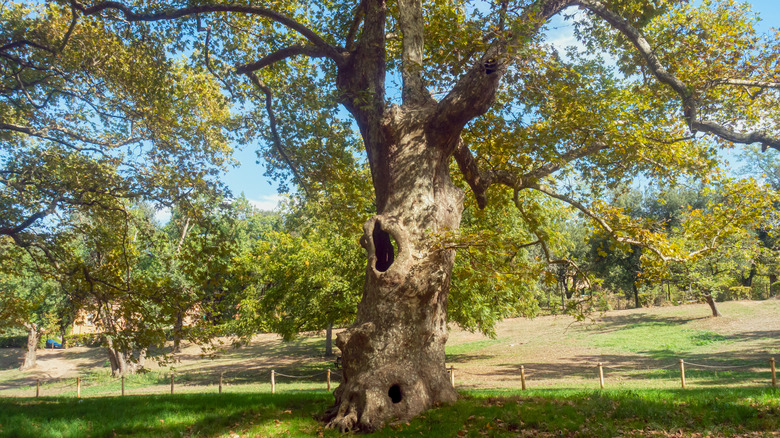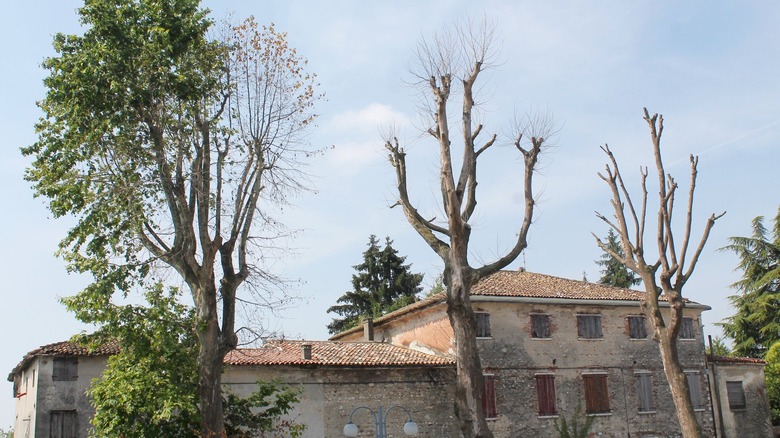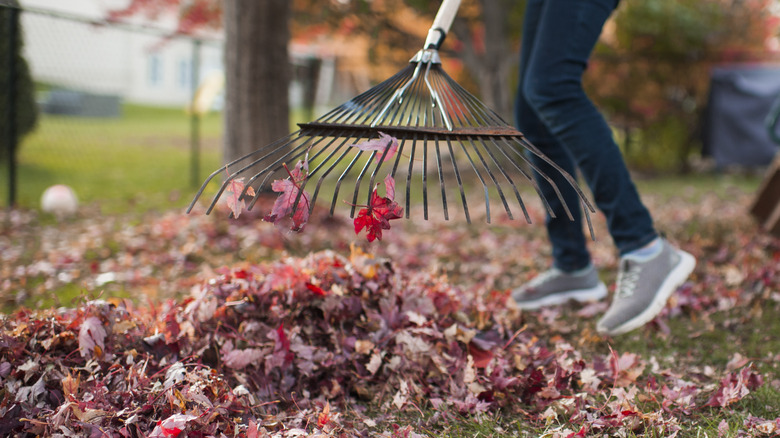Save Your London Plane Tree By Catching Diseases And Issues Early
The London plane tree is a naturally occurring hybrid species, created by crossing two members of the plane tree family: the American sycamore (Platanus occidentalis) and the Oriental plane (Planatus orientalis). The London plane tree first appeared in Europe sometime in the 16th century, and can be grown in North America in USDA zones 5 through 9. Closely resembling the American sycamore, this large deciduous tree reaches over 40 feet tall when mature and features peeling tan-gray bark and spiky, spherical fruits.
The London plane tree is a popular landscaping choice for parks and public campuses, where they can tolerate city soil and air pollution and cast an impressive amount of shade over walkways and resting spots. Normally, hybrids gain some resistance to problems that commonly plague both parent species, but the London plane tree still struggles with a number of issues that affect both American sycamores and Oriental plane trees. Frequent issues include fungal diseases such as anthracnose, powdery mildew, and canker stain. If you notice discolored, misshapen, or wilting leaves or textured, elongated wounds on the bark, your tree could be in trouble.
Once established, the London plane tree can be a real visual highlight and a fruit-bearing tree songbirds will love visiting in your yard. In order to keep your treasured London plane tree for as long as possible, it's crucial to check on it often and ensure it stays healthy. Here are the common diseases you should watch out for, signs that your tree might be sick, and steps you can take to help revive your London plane or prevent the tree from becoming unhealthy.
Fungal diseases can wreak havoc on London plane trees
London plane trees are susceptible to a number of fungal diseases. The most common disease, anthracnose, is caused by a few different types of fungi that can spread through water droplets or air and infect several tree species. At first glance, the blight in leaves and shoots and the dieback from anthracnose can mimic the effects of frost damage, which makes it difficult to easily identify a diseased tree in your yard. Powdery mildew is another common fungal infection that can threaten the health of your tree. This fungus causes a pale powder-like film on the tree's leaves, and can also warp new leaves. Luckily, London plane trees can usually shake off anthracnose and powdery mildew infections with minimal intervention from the gardener.
Canker stain, also known as plane tree wilt or canker stain of plane, is the most worrying thing to see on a London plane tree. Caused by a fungus called Ceratocystis platani, canker stain will lead to discoloration in the tree's sapwood, yellow, wilting leaves, and elongated, sunken cankers in the bark. If infected with canker stain, a London plane may only live for a few more years. The London plane is also a host to many insects, most of which aren't of major concern. However, some insects like sycamore lace bug and American plum borer can damage the tree and leave open wounds that increase the odds of deadly canker stain infection.
Addressing and preventing London plane diseases
If you're considering adding a new London plane tree to your yard, look for anthracnose-resistant cultivars. American sycamore is vulnerable to anthracnose, but by choosing a cultivar with stronger Oriental plane genetics, you can grow a tree with better resistance to the disease. 'Bloodgood,' 'Liberty,' and 'Columbia' are a few varieties that have a good resistance to the fungal disease. If you already have a London plane tree in your yard, keep a close eye on it during wet springs and summers for the development of anthracnose or powdery mildew. While the tree may recover on its own, you can help by increasing airflow around the tree and applying a fungicide treatment, if needed. To prevent powdery mildew from taking over your garden, rake and remove any fallen leaves or twigs, which can harbor fungus that re-infects the tree and other plants.
Sadly, there isn't much that can be done for trees infected with canker stain. Canker stain fungus spreads through contaminated items like saws, pruning shears, ropes, ladders, and even sawdust. It can also spread from tree to tree through root networks underground. Always disinfect your tools after using them on your London plane tree or its close relatives, the sycamore and Oriental plane. Prune your tree in winter only when the weather is dry. If a tree becomes infected, some sources suggest that you may be able to prune out the infected portions, but removing the whole tree is the best way to prevent canker stain from spreading. Infected trees and their roots should be burned to kill the fungus.


